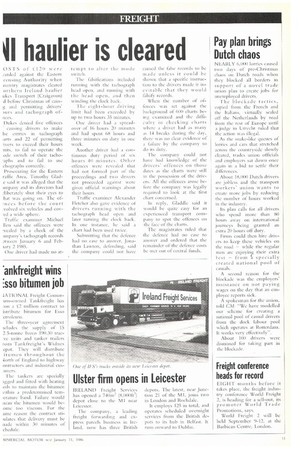II haulier is cleared
Page 11

If you've noticed an error in this article please click here to report it so we can fix it.
()STS of f12u were ;arded against the Eastern reusing Authority when iventry magistrates cleared orthern Ireland haulier ukes Transport (Craigavon) d before Christmas of causg and permitting drivers' iurs and tachograph offlees.
Dukes denied five offences causing drivers to make Ise entries in tachograph Larts and 22 of permitting ivers to exceed their hours nits, to fail to operate the ode switch of their tacho-aphs and to fail to use chographs correctly.
Prosecuting for the Eastern rafilc Area, Timothy Glad
e said it was alleged that the impany and its directors had liberately shut their eyes to .hat was going on. The ofmces before the court Lvolved six vehicles and coved a wide sphere.
Traffic examiner Michael lien said the offences were wealed by a check of the mipany's tachograph records ;AN,veen January 6 and Febiary 2 1985.
One driver had made no at tempt to alter the mode switch.
The falsifications included running with the tachograph head open, and running with the head open, and then winding the clock back.
The eight-hour driving limit had been exceeded by up to two hours 35 minutes.
One driver had a spreadover or 16 hours 211 minutes and had spent 68 hours and three minutes on duty in one week.
Another driver had a continuous duty period or six hours 40 minutes. Other offences were revealed that had not formed part of the proceedings and two drivers not proceeded against were given official warnings about their hours.
Traffic examiner Alexander Fletcher also gave evidence of drivers running with the tachograph head open and later turning the clock back. In one instance, he said a chart had been used twice.
Submitting that the defence had no case to answer, Jonathan Lawton, defending, said the company could not have caused the false records to be made unless it could be shown that a specific instruction to the drivers made it inevitable that they would falsify records.
When the number of offences was set against the background of 600 charts being examined and the difficulty in checking charts where a driver had as many as 14 breaks during the day, there was no clear evidence of a failure by the company to do its duty.
The company could not have had knowledge of the drivers' offences on those dates as the charts were still 111 the possession of the drivers. All the offences arose hefore the company was legally required to look at the first chart concerned.
In reply, Gladdle said it would be quite easy for an experienced transport company to spot the offences on the face of the charts.
The magistrates ruled that the defence had no case to answer and ordered that the remainder of the defence costs be met out of central funds.






















































